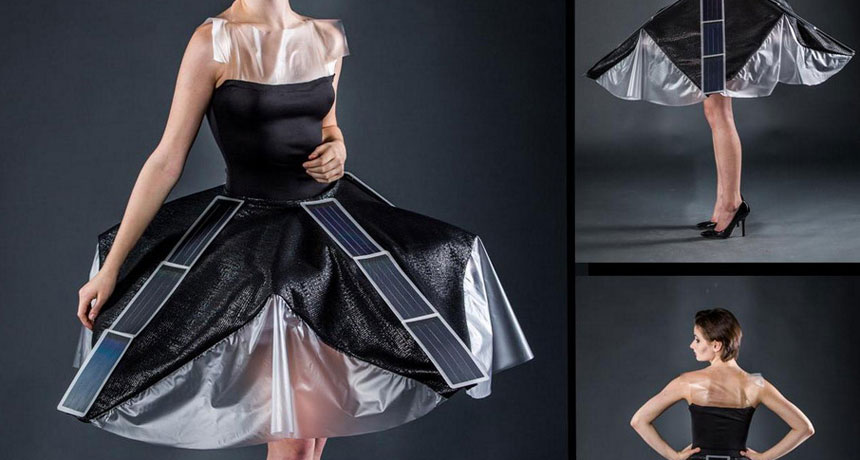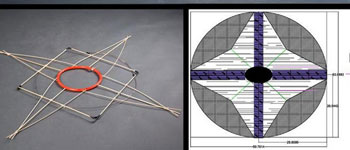This “sun” dress mixes fashion and science
A teen’s garment harvests solar energy to charge a phone or tablet

This dress supports four strips of solar panels. The photovoltaic panels convert sunlight into electricity — enough to recharge a smartphone tucked inside a hidden pocket.
John Flynn/Cloverstorm Photography
PITTSBURGH, Pa. — Many people probably don’t think of fashion and science as having a lot in common. That didn’t stop Allison Clausius from bringing the two together. Allison, 18, created a futuristic dress that can electrify a fashion runway — and charge a phone.
The senior at Sylvania Southview High School in Ohio got her scientific start during a summer internship at the nearby University of Toledo. There, as a rising junior, Allison discovered a love of solar cells.
Also called photovoltaics, solar cells are made of materials such as silicon. The materials can absorb the tiny particles of light called photons. These particles excite the negatively charged particles — electrons — in the silicon atoms. The excited electrons break away from their atoms. When electrons move from one material to another, the flow creates a current of electricity.
Solar cells can take in energy anywhere there is light. Allison reasoned that solar panels could be sewn into clothing to create fashion that also produced electricity. “I really liked solar cells,” she explains, “I love fashion a lot. I wanted to try and combine the two.”
Designing a dress with solar panels presented many challenges. “The solar panels I wanted to use were big and had a steel backing,” Allison recalls. “They weren’t flexible, I couldn’t cut them and they were very heavy.” If she was going to include solar panels in clothing, she knew they would have to be as light and flexible as possible. She settled on a lightweight, less powerful panel.

The result is a dress with a large, stiff skirt to prevent the cells from bending. Hidden pockets contain the wires connecting the solar panels to a USB port. Plug in a smartphone or tablet, place the dress in the sun and the solar panels will charge the device. The panels and wires can be taken out of the dress so the garment can be washed.
Allison showed off her design at the 2015 Intel International Science and Engineering Fair (ISEF). This annual science competition was created by Society for Science & the Public (SSP) and sponsored by Intel. (SSP publishes this blog as well as Science News for Students.) This past May, ISEF drew 1,702 finalists from more than 70 countries to Pittsburgh.
Allison’s dress isn’t for every season. Under full sun in spring or summer, the dress can easily charge a portable device. In winter or indoors, the dress can’t provide more than a trickle of power.
Those limitations haven’t kept other designers from making solar clothing. In recent years, big-name designers such as Tommy Hilfiger also have produced clothing that includes solar panels. Meanwhile, Allison says she’s still looking for more ways to combine her love of science and fashion. In the fall, she’s headed to the Fashion Institute of Technology in New York City to study fashion design.
Follow Eureka! Lab on Twitter
Power Words
(for more about Power Words, click here)
angle The space (usually measured in degrees) between two intersecting lines or surfaces at or close to the point where they meet.
atom The basic unit of a chemical element. Atoms are made up of a dense nucleus that contains positively charged protons and neutrally charged neutrons. The nucleus is orbited by a cloud of negatively charged electrons.
electric charge The physical property responsible for electric force; it can be negative or positive.
electric current A flow of charge, called electricity, usually from the movement of negatively charged particles, called electrons.
electricity A flow of charge, usually from the movement of negatively charged particles, called electrons.
electron A negatively charged particle, usually found orbiting the outer regions of an atom; also, the carrier of electricity within solids.
excite (in chemistry and physics) To transfer energy to one or more outer electrons in an atom. They remain in this higher energy state until they shed the extra energy through the emission of some type of radiation, such as light.
internship A training program where students learn advanced professional skills by working alongside experts. People who participate in these training programs are called interns. Some intern in medicine, others in the sciences, journalism or business.
particle A minute amount of something.
photon A particle representing the smallest possible amount of light or other electromagnetic radiation.
photonics Technology and research on the properties and transmission of light particles, called photons.
photovoltaic effect The creation of electricity from light.
silicon A nonmetal, semiconducting element used in making electronic circuits. Pure silicon exists in a shiny, dark-gray crystalline form and as a shapeless powder.
smartphone A cell (or mobile) phone that can perform a host of functions, including search for information on the Internet.
solar Having to do with the sun, including the light and energy it gives off.
solar cell A device that converts solar energy to electricity.
Society for Science & the Public (or SSP) A nonprofit organization created in 1921 and based in Washington, D.C. Since its founding, SSP has been not only promoting public engagement in scientific research but also the public understanding of science. It created and continues to run three renowned science competitions, including the Intel International Science and Engineering Fair (initially launched in 1950). SSP also publishes award-winning journalism in Science News (launched in 1922) and Science News for Students (created in 2003).
universal serial bus (abbreviated USB) Hardware technology used to connect a computer, smartphone, digital camera or other device to another peripheral device.